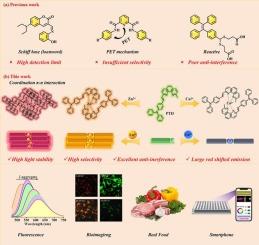基于AIE单元构建的j聚集体荧光探针用于食品和生物系统中Zn2+、Cu2+离子的分析
IF 4.6
2区 化学
Q1 SPECTROSCOPY
Spectrochimica Acta Part A: Molecular and Biomolecular Spectroscopy
Pub Date : 2025-09-09
DOI:10.1016/j.saa.2025.126921
引用次数: 0
摘要
金属离子的精确检测在食品安全、生物医学诊断和环境监测中至关重要。虽然传统的“开关”荧光探针经常被使用,但其抗干扰能力仍然有限。本研究合成了三种新型铜基荧光探针:PTA、PTP和PTD。其中,PTD表现出独特的聚集诱导发射(AIE)特性。PTD对Zn2+具有显著的选择性,这是由于Zn2+诱导的j聚集体的形成,导致荧光从绿色到黄色再到红色的浓度依赖性红移。此外,PTD对Cu2+具有快速灵敏的响应,并成功集成到基于智能手机的平台中,用于实际食品样品中Zn2+和Cu2+的半定量检测。生物应用的有效性也通过活细胞成像试验得到验证。这项工作有助于创建高选择性和抗干扰的比例荧光传感器,利用目标金属离子诱导的j -聚集体在ai探针中产生的特殊过程。本文章由计算机程序翻译,如有差异,请以英文原文为准。

J-aggregate fluorescence probe constructed based on AIE units for analysis of Zn2+, Cu2+ ions in food and biological systems
The precise detection of metal ions is crucial in food safety, biomedical diagnostics, and environmental monitoring. Although traditional “on-off” fluorescence probes are frequently utilized, their anti-interference capability remains a limitation. This study synthesized three new copper-based fluorescent probes: PTA, PTP, and PTD. Among them, PTD exhibited unique aggregation-induced emission (AIE) properties. PTD's remarkable selectivity for Zn2+ was due to the formation of Zn2+-induced J-aggregates, which resulted in a concentration-dependent fluorescence redshift from green to yellow and then to red. Additionally, PTD demonstrated a rapid and sensitive response to Cu2+, and it was successfully integrated into a smartphone-based platform for the semi-quantitative detection of Zn2+ and Cu2+ in real food samples. The effectiveness in biological applications was also validated through live-cell imaging tests. This work contributes to the creation of highly selective and interference-resistant ratiometric fluorescence sensors by leveraging the special process of target metal ion-induced J-aggregate production in AIE-based probes.
求助全文
通过发布文献求助,成功后即可免费获取论文全文。
去求助
来源期刊
CiteScore
8.40
自引率
11.40%
发文量
1364
审稿时长
40 days
期刊介绍:
Spectrochimica Acta, Part A: Molecular and Biomolecular Spectroscopy (SAA) is an interdisciplinary journal which spans from basic to applied aspects of optical spectroscopy in chemistry, medicine, biology, and materials science.
The journal publishes original scientific papers that feature high-quality spectroscopic data and analysis. From the broad range of optical spectroscopies, the emphasis is on electronic, vibrational or rotational spectra of molecules, rather than on spectroscopy based on magnetic moments.
Criteria for publication in SAA are novelty, uniqueness, and outstanding quality. Routine applications of spectroscopic techniques and computational methods are not appropriate.
Topics of particular interest of Spectrochimica Acta Part A include, but are not limited to:
Spectroscopy and dynamics of bioanalytical, biomedical, environmental, and atmospheric sciences,
Novel experimental techniques or instrumentation for molecular spectroscopy,
Novel theoretical and computational methods,
Novel applications in photochemistry and photobiology,
Novel interpretational approaches as well as advances in data analysis based on electronic or vibrational spectroscopy.

 求助内容:
求助内容: 应助结果提醒方式:
应助结果提醒方式:


